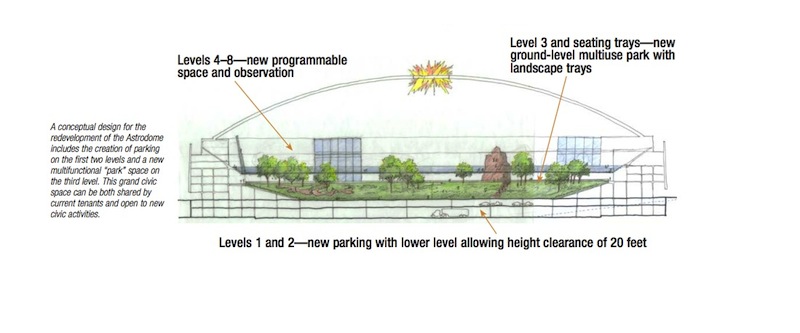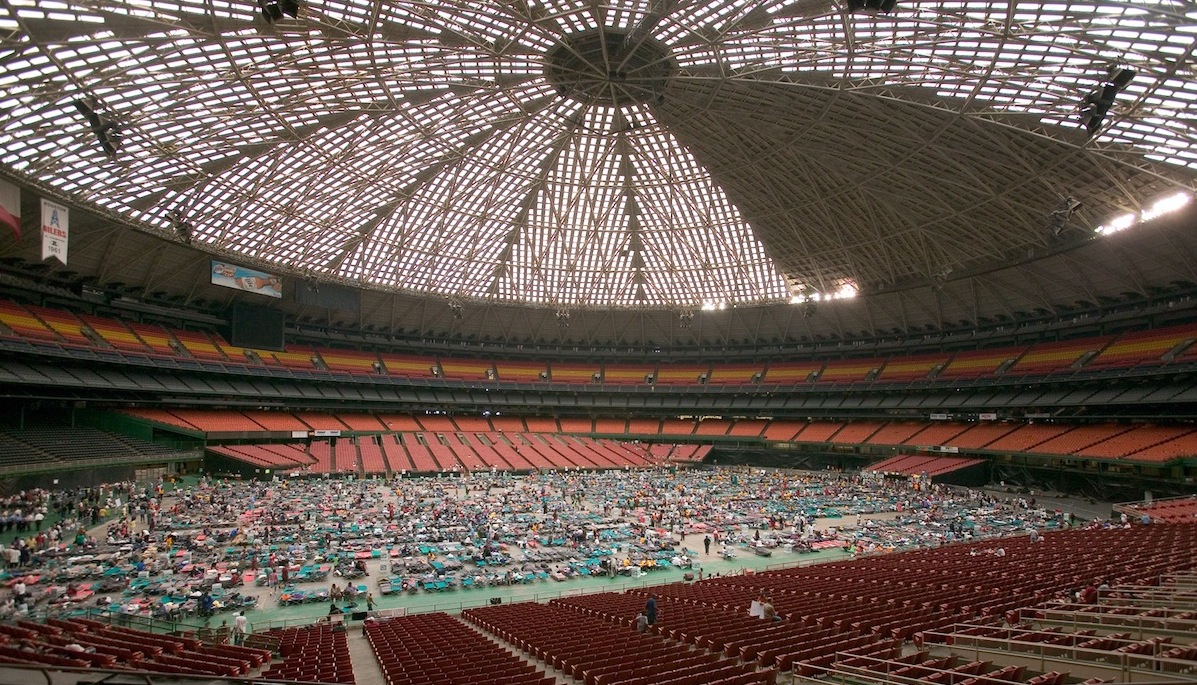An advisory panel of developers, architects, business leaders, and other land-use experts has proposed turning Houston’s decrepit Astrodome, which has been vacant since 2008, into a multipurpose park and civic, programmable space for festivals, concerts, and exhibits.
This is the latest in a series of proposals that, over the past few years, have been floated and, to this point, rejected. They have included converting the Astrodome into a luxury hotel and a movie studio.
In November 2013, voters turned down a $213 million referendum to renovate the building into a convention center and exhibition space. A month later, the Astrodome’s three exterior pedestrian ramp towers were torn down. The National Trust for Historic Preservation has listed the Astrodome among the 11 most endangered historic places.
But the city’s council has rejected the Astrodome’s outright demolition until its final disposition is determined, and because the council fears razing a structure this large could cause damage to the surrounding development.
Houston's city council has rejected the Astrodome’s outright demolition until its final disposition is determined, and because the council fears razing a structure this large could cause damage to the surrounding development.
The one-million-sf, spaceship-shaped building was the world’s first multipurpose domed sports stadium. It is now called NRG Astrodome, and is part of the 350-acre NRG Park complex in Harris County, Texas, which includes a stadium with a retractable roof where the National Football League’s Houston Texans franchise plays, and an arena wherre the popular Houston Livestock Show and Rodeo is held. NRG Park is also near Texas Medical Center, the world’s largest.
Last December, the county and the National Trust for Historic Preservation turned to Urban Land Institute to provide strategic advice. (Harris County’s Sports and Convention Corporation had chimed in, too, suggesting the space be used as a public park.) ULI sent a 10-person Advisory Services Panel, chaired by Los Angeles developer Wayne Ratkovich, to visit the Astrodome for three days. That panel came up with a series of recommendations, which ULI released on March 24.
The panel acknowledges that the Astrodome was now “a shadow of its former self.” But it also refers to the building as an “icon,” whose place in history should be part of any renovation plan. A “new vision” for the stadium, the panel states, could include a museum or educational exhibits that focus on science, technology, engineering, the arts, and math.
The panel’s report lays out a detailed renovation strategy:
• 1,500 parking spaces would be added to the 26,000 slots that already surround the building. That parking would be located in the building’s Levels 1 and 2, with the lower level having 20-foot-high clearance.
• Level 3, which currently consists of vast open space and seating trays, would be converted into a new ground-floor multi-use space that, ULI suggests, could include a public park.
• Levels 4 through 8 would be converted to new programmable areas, such as exhibits “to extend the game-day experience for the Houston Texas, new spaces for [the rodeo] and added space for the Offshore Technology Conference. (One of the key goals of ULI’s plan is to lure the rodeo event back into the Astrodome. The rodeo relocated in 2003.) These programmable spaces could also be used for community festivals, farmers markets, movie nights, charity events and other functions that might also provide new revenue streams.
The panel envisions 450,000 sf of leasable space within the Astrodome’s perimeter, which could accommodate restaurants, retail, and other tenants.
Other recommendations include a complete rehab of the building’s dome, and the creation of new outdoor public space or a live oak allée as a promenade between the light-rail station and the Astrodome’s east entrance. Along that allée there would be permanent outdoor pavilions. The building’s outside area would be upgraded with hardscape and landscape features.

The construction cost for this project, estimates the panel, would be around $242.45 million. (The Astrodome opened in 1965 at a cost of $35 million in taxpayer money.) The panel recommends that new capital streams to pay for this construction would need to be explored, including federal, state, county, and city funds; tax increment reinvestment zones; historic tax credits; Harris County redevelopment; and philanthropy.
To get all moving forward, the panel says the county should assign a project “czar,” as well as identify and empower an NRG Park “champion,” perhaps from the ranks of business or not-for-profit organizations.
Independent marketing and design consultants would need to be hired, and after a plan is conceived, it should be submitted to public scrutiny, says the panel.
The goal would be to complete this plan and break ground on the renovation before the 2017 Super Bowl, so that it could be advertised during the event. The panel expects the renovation to take a year or two to complete, and foresees “future public/private project opportunities”—including hotel, mixed-use, and retail development—in the years 2020-2025.
In its report, the panel says Harris County and its residents are at “an intersection of a series of choices: to act rather than procrastinate, to demand quality rather than settle on mediocrity, to create a common interest rather than simply protect self interests, [and] to [either] protect the status quo or reach for the future.”
Related Stories
| Aug 11, 2010
Populous selected to design 'crystalline skin' stadium for 2014 Winter Olympics
Russian officials have selected global architect Populous to design the main stadium for the 2014 Winter Olympic and Paralympic Games in Sochi, Russia. The 40,000-seat stadium will feature a crystalline skin that "engages with its surroundings by day and provides an iconic representation of the color and spectacle of the games when illuminated at night," said Populous senior principal John Barrow.
| Aug 11, 2010
Best AEC Firms of 2011/12
Later this year, we will launch Best AEC Firms 2012. We’re looking for firms that create truly positive workplaces for their AEC professionals and support staff. Keep an eye on this page for entry information. +
| Aug 11, 2010
Clark Group, Mortenson among nation's busiest state/local government contractors, according to BD+C's Giants 300 report
A ranking of the Top 40 State/Local Government Contractors based on Building Design+Construction's 2009 Giants 300 survey. For more Giants 300 rankings, visit /giants
| Aug 11, 2010
Portland Cement Association offers blast resistant design guide for reinforced concrete structures
Developed for designers and engineers, "Blast Resistant Design Guide for Reinforced Concrete Structures" provides a practical treatment of the design of cast-in-place reinforced concrete structures to resist the effects of blast loads. It explains the principles of blast-resistant design, and how to determine the kind and degree of resistance a structure needs as well as how to specify the required materials and details.
| Aug 11, 2010
Gensler, HOK, HDR among the nation's leading reconstruction design firms, according to BD+C's Giants 300 report
A ranking of the Top 100 Reconstruction Design Firms based on Building Design+Construction's 2009 Giants 300 survey. For more Giants 300 rankings, visit http://www.BDCnetwork.com/Giants
| Aug 11, 2010
Gensler among eight teams named finalists in 'classroom of the future' design competition
Eight teams were recognized today as finalists of the 2009 Open Architecture Challenge: Classroom. Finalists submitted designs ranging from an outdoor classroom for children in inner-city Chicago, learning spaces for the children of salt pan workers in India, safe spaces for youth in Bogota, Colombia and a bamboo classroom in the Himalayan mountains.
| Aug 11, 2010
ASHRAE introduces building energy label prototype
Most of us know the fuel efficiency of our cars, but what about our buildings? ASHRAE is working to change that, moving one step closer today to introducing its building energy labeling program with release of a prototype label at its 2009 Annual Conference in Louisville, Ky.
| Aug 11, 2010
10 tips for mitigating influenza in buildings
Adopting simple, common-sense measures and proper maintenance protocols can help mitigate the spread of influenza in buildings. In addition, there are system upgrades that can be performed to further mitigate risks. Trane Commercial Systems offers 10 tips to consider during the cold and flu season.







